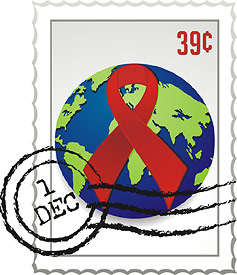
After 30 years of living with this horrifying disease, we are still deep in crises surrounding the testing, treatment, and prevention of HIV/AIDS nationally and globally.
Now, in 2011, AIDS is as deadly as ever, yet many young people rationalize and diminish the dangers of having unprotected sex. Still, the reality remains that we do not have a cure, HIV/AIDS is fatal and infections continue to occur at an alarming rate.
A sort of amnesia has set in: Attention has faded, but the epidemic has not.
Consider these recent statistics:
- 33.3 million people currently live with HIV worldwide
- There are 2,700,000 new infections every year
- In North America, 1.5 million people live with HIV. Of these, 70,000 are new infections. Fourteen thousand people die of AIDS in North America every year.
- AIDS is a major killer in the United States: Well over half a million Americans have died of AIDS
- 56,000 people are newly infected each year in the United States
- Men having sex with men (MSM) continues to be the primary avenue of infection for HIV
- For every person who begins HIV/AIDS treatment, two to three others are newly infected
The single most effective way of preventing the spread of HIV/AIDS is to remain conscious of the disease and act appropriately based on the information one has. This means getting tested regularly (increasingly important if one is higher risk – multiple partners, MSM, unprotected sex). For those who are HIV-positive, it means becoming informed about responsibilities, legal rights, treatment and safe sex practices. Counselors, psychologists, therapists and nurses are crucial in providing these essential services.
Beyond the medical concerns, HIV/AIDS presents therapists and their clients with a complex of issues:
- Men who have sex with men (MSM) remain the highest risk group (48%) for becoming infected and infecting others with HIV.
- Many men who have sex with other men do NOT identify as gay and spread HIV to their heterosexual partners.
- HIV takes a disproportionate toll on communities of color, with the most severe impact among African-Americans, followed by Hispanics/Latinos.
- In these communities, fear of discussing issues regarding men having sex with men often prevents effective counseling for those who need it.
- The number one killer of African-American women aged 25-34 is AIDS.
- People with HIV continue to face stereotyping, social isolation, loss of social or financial support, barriers to accessing housing, employment, and various social and medical services, and physical or emotional abuse.
- Suicide remains a threat to a client with HIV despite advances in treatment and palliative care.
- Most HIV-positive individuals are in need of support and counseling throughout the remainder of their lives.
Those taking this course are encouraged to explore the ethical and legal issues of this area in this complimentary course:
Ethical, Legal, and Clinical Complexities in Psychotherapy with Clients with HIV/AIDS
This 10 CE Unit course fulfills the Law-Ethics requirement and the HIV/AIDS requirement in most states.
These two courses will help a practitioner become or remain competent and informed in addressing HIV/AIDS in their respective practices.